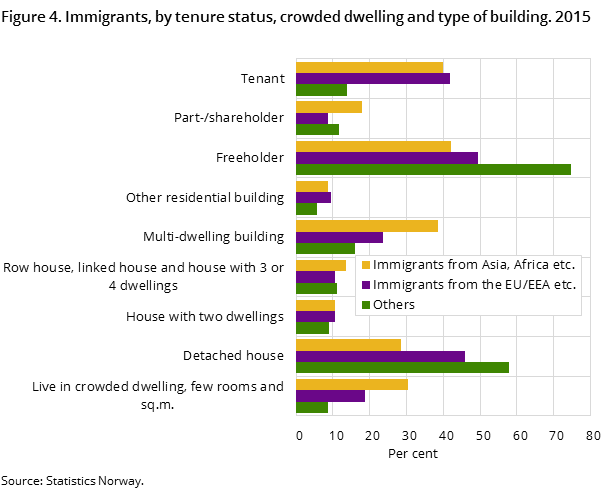Content
Published:
This is an archived release.
4.2 million owner occupiers
Almost eight out of ten households are home owners, and almost half live in a detached house. One out of ten persons live in a crowded dwelling, and this is most frequent among households with children. Crowded dwellings are most common in cities, and home ownership is less common in households with the lowest incomes.
| 2015 | ||
|---|---|---|
| Number | Per cent | |
| Households, freeholders | 1 457 979 | 63.2 |
| Households, part-/shareholders | 329 120 | 14.3 |
| Households, tenants | 521 290 | 22.6 |
| Households in detached house | 1 118 983 | 48.5 |
| Households in multi-dwelling building | 544 064 | 23.6 |
| Persons in crowded dwellings, few rooms and sq.m. | 541 968 | 10.7 |
| Children and youth (0-19 years) in crowded dwellings, few rooms and sq.m. | 228 808 | 18.3 |




New statistics on housing conditions based on administrative registers confirm that Norway is dominated by owner occupiers, detached houses are most common, and most people live in spacious dwellings. However, there are geographical variations, and the prevalence of ownership is lower and the overcrowding rate is higher in certain groups of the population.
Seventy-seven per cent of the 2.3 million private households are owner occupiers, while 23 per cent are tenants. Owner households are on average larger than tenant households, and 4.2 million Norwegians, or 83 per cent of the population, live in a dwelling owned by the household.
The highest share of ownership is among couples with children. Ninety-three per cent of all couples with children aged 7-17 years own their own dwelling. Single parents are more often tenants, particularly single parents with young children (0-5 years), where half are tenants. The share of owners is also quite low among one-person households, where almost half are tenants.
More than half of the population in detached houses
A total of 48 per cent of all households live in detached houses. Twenty-four per cent live in multi-dwelling buildings and 21 per cent of the households live in a row house, linked house or similar. The remaining 8 per cent live in other buildings.
Almost seven out of ten couples with children aged 7-17 years live in detached houses. The shares living in multi-dwelling buildings are highest among one-person households and single parents, with 35 and 27 per cent respectively. Since living in detached houses is most common among larger households, a total of 55 per cent of all persons and 61 per cent of all children and young persons aged 0-19 years live in this kind of dwelling.
Approximately 540 000 persons (11 per cent) in 160 000 households (7 per cent) live in a crowded dwelling. This is most common for larger households, particularly households with children. Almost one out of four children aged 0-5 years live in a crowded dwelling.
One out of four Oslo inhabitants in rented dwellings
Among the larger municipalities, we find the highest shares of tenanted households in Trondheim and Tromsø, with 32 and 31 per cent respectively. The shares in Oslo and Bergen are 30 and 29 per cent. In municipalities such as Stavanger, Kristiansand and Drammen, approximately one out of four households are tenants. In the municipalities Fredrikstad, Sandnes, Bærum, Skien, Sarpsborg and Asker, the shares are below one out of five. If we switch from households to persons, the large municipality with the highest share of tenants is Oslo, where one out of four persons live in a rented dwelling.
The large municipalities and some of Oslo’s neighbouring municipalities are also distinct in relation to the share of part-/shareholder households. In Oslo, one out of three households are part-/shareholders, while in Drammen, Bergen and Trondheim, the figure is one out of four.
Most crowded in cities
Living in crowded dwellings is also most prevalent in the cities, mostly due to the differences in composition of households and dwelling types. In Oslo, 22 per cent of the population, corresponding to 139 000 persons, live in crowded dwellings. In Bergen, Trondheim and Tromsø, 15-14 per cent of the population live in crowded dwellings.
Four out of ten of the at-risk-of poverty households are owner occupiers
In households below the at-risk of poverty threshold, ownership is less frequent and living in crowded dwellings more frequent than in the population as a whole. Thirty-one per cent are freeholders, 11 per cent are part-/shareholders and 15 per cent live in crowded dwellings.
Households in the lowest income quartile cover a larger group than those at risk of poverty, and in comparison, the share of owners is slightly higher. The other comparable figures are 36 per cent freeholders and 13 per cent are part-/shareholders. The overcrowding rate is 13 per cent.
Social assistance recipients and dwelling support recipients overlap to a certain degree, so these two groups share some characteristics in the housing market. Fourteen per cent of the dwelling support recipients and 17 per cent of the social assistance recipients live in crowded dwellings, and the shares of owners are low. Only 34 per cent of dwelling support recipients and 37 per cent of social assistance recipients are owners, compared to 77 per cent in the population of households.
Immigrants in the housing market
Sixty per cent of immigrants from Asia, Africa etc. live in an owner occupier household. Among immigrants from the EU/EEA etc., the share is even lower, at 58 per cent. The corresponding share among non-immigrants is 86 per cent.
Comparing immigrants and non-immigrants, we also find disparities in terms of dwelling types. Only 28 per cent of immigrants from Asia, Africa etc. live in detached houses, while multi-dwelling buildings is the most common, with 39 per cent living in such dwellings. Corresponding shares among non-immigrants are 58 and 16 per cent. Forty-six per cent of the immigrants from the EU/EEA etc. live in detached houses, and 24 per cent live in multi-dwelling buildings.
Type of dwelling is correlated to the crowding rate, and three out of ten immigrants from Asia, Africa etc. live in crowded dwellings. Among immigrants from the EU/EEA etc., the corresponding share is almost two out of ten. More than half, 51 per cent, of immigrants from Asia, Africa etc. aged 0-19 years live in crowded dwellings. Among young non-immigrants, the share is 17 per cent.
Contact
-
Mari Lande With
E-mail: mari.lande.with@ssb.no
tel.: (+47) 98 43 36 65
